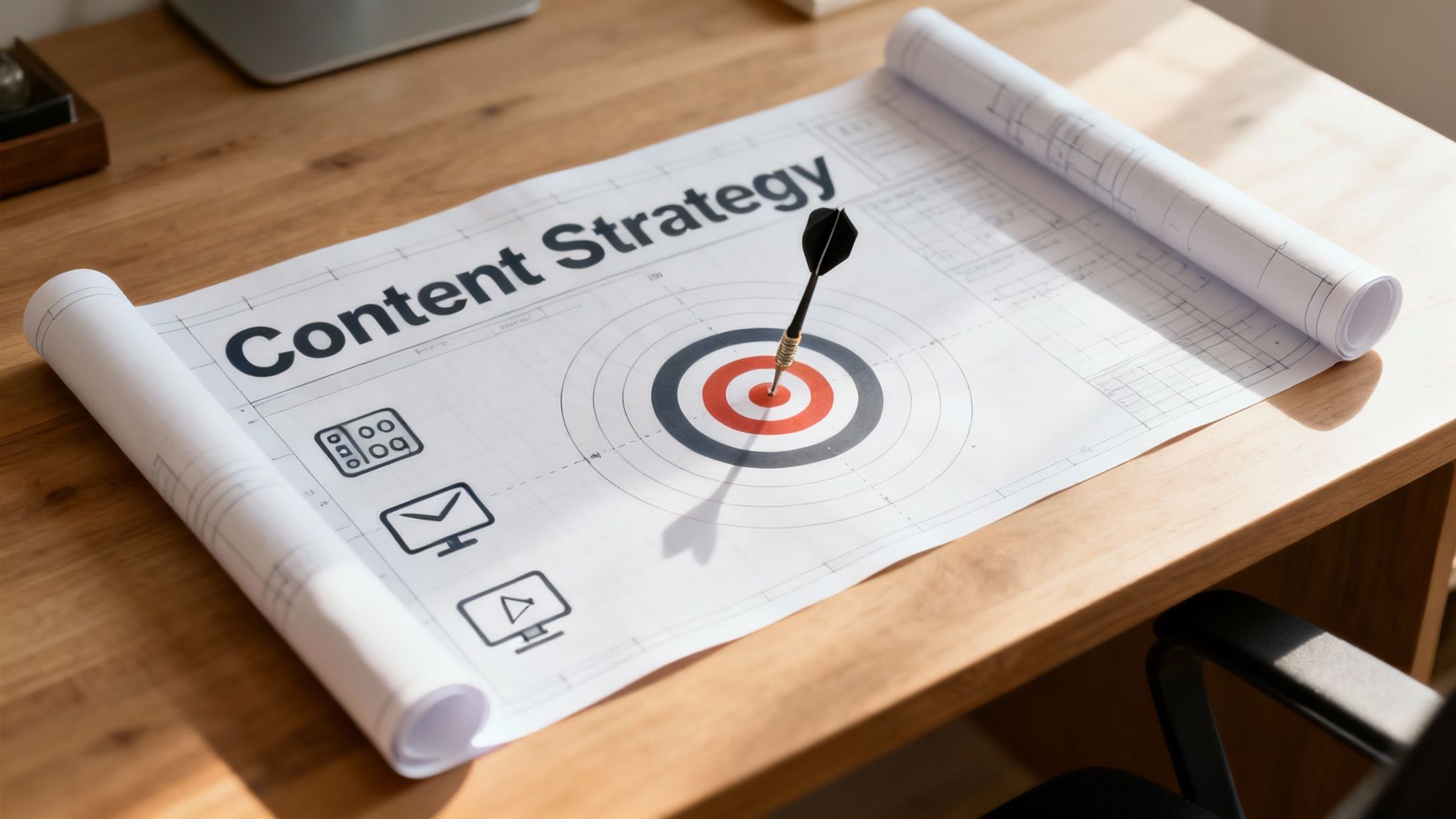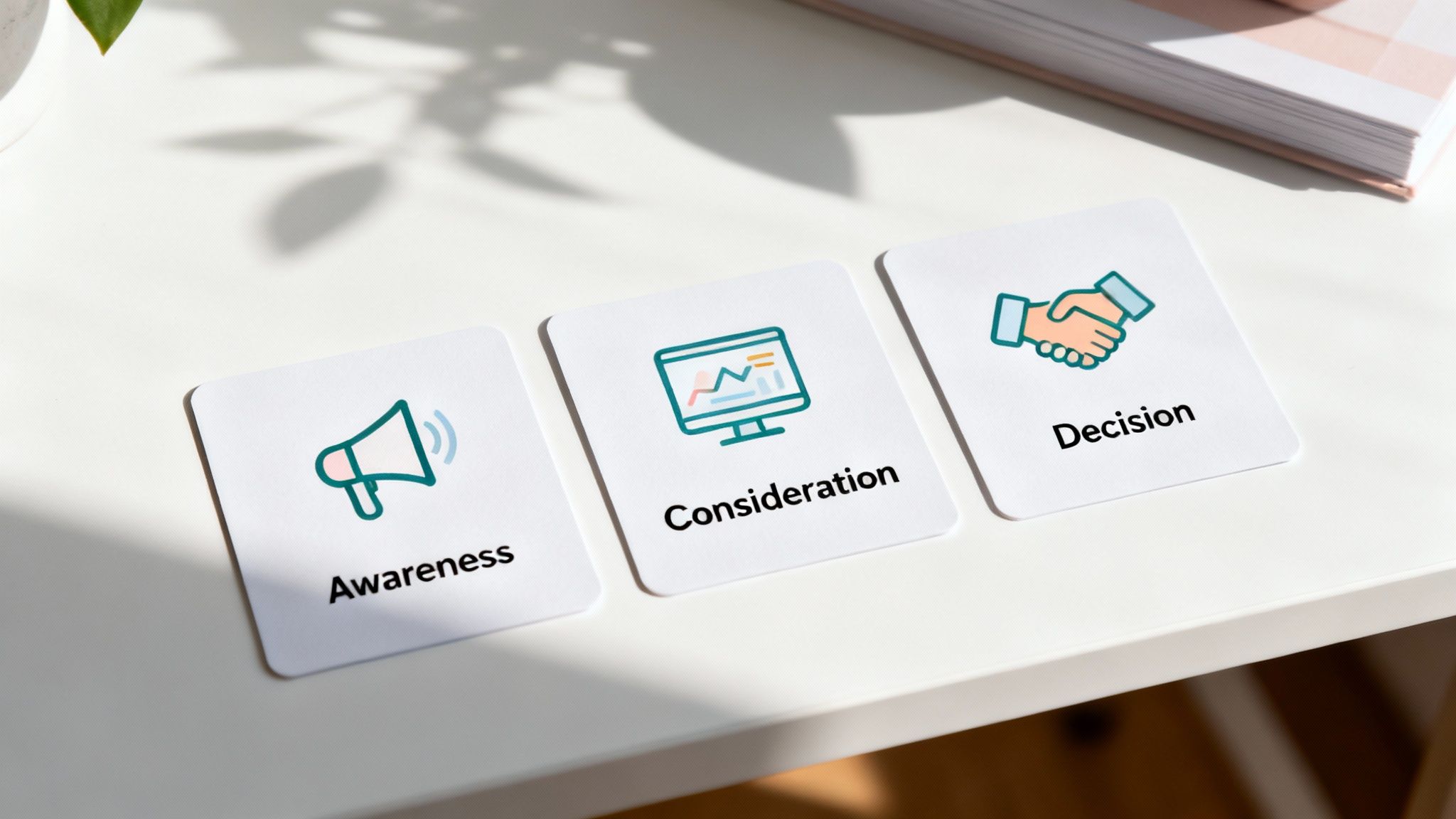Content marketing is more than just publishing blog posts and hoping for the best. It’s a strategic business function designed to build trust, generate leads, and grow a brand’s presence. But what separates a successful program from a collection of random assets? The answer is a documented content marketing strategy.
In this Q&A briefing, we’ll answer the core questions marketing professionals ask when building a plan that delivers real results. We’ll cover everything from defining your purpose to measuring your return on investment (ROI).
What is a content marketing strategy, and how is it different from just “publishing content”?

Simply “publishing content” is a series of tactics—individual actions like writing a blog post, sharing on social media, or sending a newsletter. A content marketing strategy is the documented game plan that connects all those tactics to a specific business goal.
Think of it like building a house. Publishing content without a strategy is like randomly stacking bricks and hoping it becomes a home. A strategy is the architect’s blueprint. It tells you exactly where each brick goes, what its purpose is, and how it all connects to create a strong, stable structure.
- Publishing Content (Tactics): Focuses on the what. “We need to create a blog post this week.”
- Content Strategy (The Plan): Focuses on the why and who. “We will create a blog post about topic X to attract marketing managers struggling with Y, with the goal of generating 50 new MQLs this quarter.”
A strategy turns your content from a creative hobby into a predictable engine for growth. For a fantastic, real-world example of how these principles come to life, this SaaS content marketing strategy playbook breaks down the entire process from goal-setting all the way to execution.
Why is having a documented content strategy important for consistency and ROI?

A documented strategy is your team’s single source of truth. It transforms content from a chaotic, creative exercise into a measurable business asset. Here’s why it’s critical:
- It Enforces Consistency: Without a plan, your brand’s voice fractures. The tone on your blog feels different from your emails, which feels different from your social posts. A documented strategy sets clear guardrails for your brand voice, tone, and messaging, building a recognizable and trustworthy presence.
- It Aligns the Entire Organization: When marketing, sales, product, and support are all working from the same playbook, you create a seamless customer experience. New hires get up to speed faster, and freelancers or agencies can plug into your workflow without missing a beat.
- It Proves ROI: A documented plan connects your content efforts to clear, measurable goals. Instead of just reporting on vanity metrics like page views, you can show leadership how your content directly influences lead generation, customer acquisition cost (CAC), and revenue. This is how you secure bigger budgets and earn a strategic seat at the table.
Bottom line? A documented plan turns your content from a random expense into a predictable engine for growth.
What are the essential components of a strong content marketing strategy?
A powerful strategy is built on a few non-negotiable pillars. If you skip one, the whole system can stall out. Here are the core components you need to assemble an effective plan.
1. Clear Business Objectives
Before you write a single word, you must know what you’re trying to achieve. Are you aiming to boost brand awareness, generate qualified leads, or improve customer retention? Each goal requires a completely different type of content. Defining this upfront makes your efforts focused and measurable.
2. Deep Audience Personas
You can’t create content that resonates if you don’t know who you’re talking to. A deep audience persona is an empathetic sketch of your ideal customer, detailing their goals, challenges, and motivations. This ensures you create content that speaks directly to their problems and makes them feel understood.
3. Strategic Topic and Keyword Research
This isn’t about stuffing keywords into articles; it’s about discovering the actual language your audience uses to describe their problems. This research is the bridge between what your brand wants to say and what your audience is already searching for, ensuring your content has a built-in audience.
4. A Content Creation and Management Workflow
Consistency is impossible without a solid operational workflow. This blueprint defines every step, from idea to publication, clarifying roles, setting quality standards, and ensuring your content engine runs smoothly. A strong content strategy isn’t just about creating; it also demands effective management of all your digital assets. Using the right Digital Asset Management (DAM) tools can centralize your media files, making collaboration and repurposing content much easier.
5. A Multi-Channel Distribution Plan
Creating great content is only half the battle. Your distribution plan outlines exactly how you’ll get it in front of your target audience using a mix of owned (blog, email), earned (SEO, PR), and paid (social ads) channels. When you need a hand managing all this, it’s worth exploring the top content marketing tools that can streamline everything from research to analytics.
How do you identify and understand your target audience?

Great content isn’t about what you want to say; it’s about what your audience desperately needs to hear. To truly understand them, you must go beyond surface-level demographics and build empathy. Here’s how:
Mine Your Internal Goldmines
The best audience intelligence you have is already inside your company. Your customer-facing teams get raw, unfiltered feedback every day.
- Talk to Sales: What objections come up constantly? What are the “aha!” moments when a prospect finally understands your value? They know the exact words customers use to describe their pain points.
- Analyze Support Tickets: This is a literal log of customer frustrations and questions. Look for patterns—they point directly to knowledge gaps your content can fill.
- Review Onboarding Feedback: Where do new customers get stuck? This is your roadmap for creating genuinely helpful tutorials and guides.
Listen to the Outside World
Your ideal customers are talking about their challenges every day in public forums. You just have to know where to listen.
- Monitor Social Communities: Keep an eye on conversations on LinkedIn, Reddit, and niche forums. Pay close attention to the questions people are asking.
- Read Competitor Reviews: Scour sites like G2, Capterra, or TrustRadius. What are their customers’ biggest complaints? Those gaps are massive opportunities for you.
- Conduct Interviews: Don’t be afraid to just ask. A 15-minute chat with a few of your best customers can provide more clarity than weeks of guesswork.
Which types of content work best at different stages of the funnel?

Delivering the right message in the wrong package is a classic marketing mistake. Matching your content format to the customer’s stage in their journey—Awareness, Consideration, or Decision—is crucial for guiding them smoothly to the next step.
Awareness Stage (Top of Funnel)
Goal: Get on their radar and answer initial questions. The content should be educational, shareable, and easily discoverable.
- Best Formats: SEO-optimized blog posts, shareable infographics, short social media videos, and podcasts.
Consideration Stage (Middle of Funnel)
Goal: Nurture interest and showcase your expertise. The content needs to go deeper and help them evaluate their options.
- Best Formats: In-depth webinars, downloadable guides/e-books, case studies, and comparison sheets.
Decision Stage (Bottom of Funnel)
Goal: Build trust and remove final barriers to purchase. The content must make choosing you feel like the safest, most obvious choice.
- Best Formats: Customer testimonial videos, product demos, free trials, and detailed FAQs.
The Power of Video Across the Funnel
Video is uniquely powerful because it can be adapted for any stage.
- Awareness: Short, engaging explainer videos can simplify complex ideas and grab attention on social media.
- Consideration: In-depth tutorials or customer story videos build trust and demonstrate your product’s value.
- Decision: Personalized demos or onboarding sequences can close the deal and ensure new customers succeed.
Video increases engagement, builds an emotional connection, and makes your brand more human.
How do you measure the success of a content marketing strategy?
Creating content without measuring its impact is like flying blind. To prove your strategy is working, you must connect your efforts to real business outcomes, moving beyond vanity metrics to focus on KPIs that leadership cares about.
Your measurement plan should directly reflect your initial business goals.
- If your goal is Brand Awareness: Track metrics like organic traffic, keyword ranking improvements, and social media reach. These show how many new eyeballs are discovering your brand.
- If your goal is Lead Generation: Focus on conversion rates (e.g., e-book downloads), cost per lead (CPL), and the number of marketing qualified leads (MQLs) generated by your content.
- If your goal is Customer Engagement and Loyalty: Measure average session duration, repeat visitor rate, and comments/shares. These indicate you’re building a community, not just attracting fly-by traffic.
For more on what to track, especially with video, explore these key online video metrics to get a clearer picture of performance.
To keep your content engine running effectively, you’ll need a steady stream of fresh ideas. When you’re looking for inspiration on new and compelling formats, browsing a resource like Wideo’s video ideas page can spark creativity. And when it comes to bringing those ideas to life, scaling high-quality content creation is key. Using a tool like Wideo’s video automation solution allows you to produce personalized videos efficiently, ensuring your strategy can grow without sacrificing quality.
What mistakes should marketers avoid when building their strategy?
Even the best-laid plans can fail if you fall into a few common traps. Steering clear of these classic blunders will dramatically increase your chances of success.
- Creating Content Without a Distribution Plan: This is the biggest one. Don’t spend 90% of your effort on creation and only 10% on promotion. Your distribution plan isn’t an afterthought—it should be baked into your strategy from day one.
- Focusing on Quantity Over Quality: In today’s crowded world, mediocre content doesn’t just get ignored; it can damage your brand’s credibility. One exceptional, in-depth asset is worth more than ten shallow posts that offer no real value.
- Ignoring Audience Research: Creating content based on what you think your audience wants is a massive gamble. Ground your strategy in real data from sales calls, support tickets, and social listening to ensure you’re solving actual problems.
- Failing to Set Measurable Goals: Vague objectives like “increase brand awareness” are impossible to track. Tie every piece of content to a specific, measurable KPI. This data-driven approach is what separates a professional content operation from a hobby.






